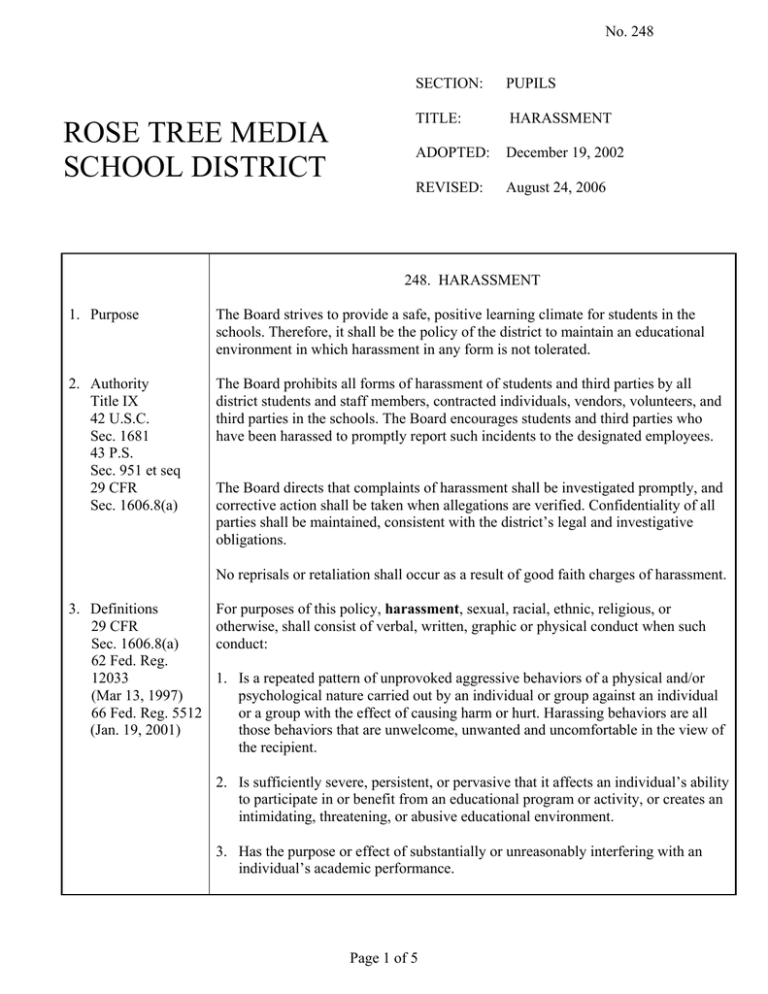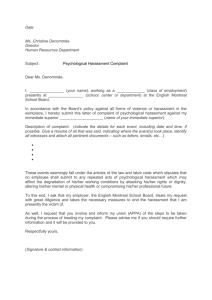
No. 248
ROSE TREE MEDIA
SCHOOL DISTRICT
SECTION:
PUPILS
TITLE:
HARASSMENT
ADOPTED:
December 19, 2002
REVISED:
August 24, 2006
248. HARASSMENT
1. Purpose
The Board strives to provide a safe, positive learning climate for students in the
schools. Therefore, it shall be the policy of the district to maintain an educational
environment in which harassment in any form is not tolerated.
2. Authority
Title IX
42 U.S.C.
Sec. 1681
43 P.S.
Sec. 951 et seq
29 CFR
Sec. 1606.8(a)
The Board prohibits all forms of harassment of students and third parties by all
district students and staff members, contracted individuals, vendors, volunteers, and
third parties in the schools. The Board encourages students and third parties who
have been harassed to promptly report such incidents to the designated employees.
The Board directs that complaints of harassment shall be investigated promptly, and
corrective action shall be taken when allegations are verified. Confidentiality of all
parties shall be maintained, consistent with the district’s legal and investigative
obligations.
No reprisals or retaliation shall occur as a result of good faith charges of harassment.
3. Definitions
29 CFR
Sec. 1606.8(a)
62 Fed. Reg.
12033
(Mar 13, 1997)
66 Fed. Reg. 5512
(Jan. 19, 2001)
For purposes of this policy, harassment, sexual, racial, ethnic, religious, or
otherwise, shall consist of verbal, written, graphic or physical conduct when such
conduct:
1. Is a repeated pattern of unprovoked aggressive behaviors of a physical and/or
psychological nature carried out by an individual or group against an individual
or a group with the effect of causing harm or hurt. Harassing behaviors are all
those behaviors that are unwelcome, unwanted and uncomfortable in the view of
the recipient.
2. Is sufficiently severe, persistent, or pervasive that it affects an individual’s ability
to participate in or benefit from an educational program or activity, or creates an
intimidating, threatening, or abusive educational environment.
3. Has the purpose or effect of substantially or unreasonably interfering with an
individual’s academic performance.
Page 1 of 5
248. HARASSMENT - Pg. 2
4. Otherwise adversely affects an individual’s learning opportunities.
29 CFR
Sec. 1604.11 (a)
For the purposes of this policy, sexual harassment shall consist of unwelcome
sexual advances, requests for sexual favors; and other inappropriate verbal, written,
graphic, or physical conduct of a sexual nature when:
1. Submission to such conduct is made explicitly or implicitly a term or condition
of a student’s academic status.
2. Submission to or rejection of such conduct is used as a basis for academic or
work decisions affecting the individual.
3. Such conduct deprives a student of educational aid, benefits, services, or
treatments.
4. Such conduct is sufficiently severe, persistent, or pervasive that it has the
purpose or effect of substantially interfering with the student’s school
performance or creating an intimidating, hostile, or offensive education
environment.
Examples of conduct that may constitute sexual harassment include, but are not
limited to, sexual flirtations, advances, touching or propositions, verbal abuse of a
sexual nature, graphic or suggestive comments about an individual’s dress or body,
sexually degrading words to describe an individual, jokes, pin-ups, calendars,
objects, graffiti, vulgar statements, abusive language, innuendoes, references to
sexual activities, overt sexual conduct, or any conduct that has the effect of
unreasonably interfering with a student’s ability to work or learn, or creates an
intimidating, hostile, or offensive learning or working environment.
Racial, ethnic, or religious harassment/intimidation means any alleged or
confirmed act directed against or occurring to a person, private property, or public
property on the basis of race, ethnicity, or religious affiliation. An incident need not
involve an act that constitutes a criminal offense.
Individuals or groups are in violation of this policy if they engage in harassing or
intimidating conduct at school, on school grounds, while engaging in schoolsanctioned activities or while traveling to or from school. Unacceptable conduct
includes, but is not limited to:
1. Making remarks directly or indirectly, such as name-calling, fighting words,
racial slurs or jokes that demean individuals or groups.
2. Physically threatening or harming individuals or groups.
Page 2 of 5
248. HARASSMENT - Pg. 3
3. Damaging, defacing or destroying the private property of any person.
Individuals who are not the direct recipient of harassment or intimidation may also
experience a hostile environment. Third party individuals shall, therefore, have the
same right to act under this policy as those directly victimized.
Actual or threatened retaliation against a person who complains or intends to
complain of harassment or intimidation will be prohibited and will be subject to
appropriate disciplinary action.
4. Delegation of
Responsibility
Pol. 103
In order to maintain an educational environment that discourages and prohibits
unlawful harassment, the Board designates the Director of Human Resources as the
district’s Compliance Officer.
The Compliance Officer shall publish and disseminate this policy and complaint
procedure at least annually to students, parents/guardians, employees, independent
contractors, vendors, and the public. The publication shall include the position,
office address, and telephone number of the Compliance Officer.
The administration shall be responsible to provide training for students and
employees regarding all aspects of harassment.
Each staff member shall be responsible to maintain an educational environment free
from all forms of harassment.
Each student shall be responsible to respect the rights of all other students and
district employees and to ensure an atmosphere free from all forms of harassment.
The building principal or designee shall be responsible to complete the following
duties when receiving a complaint of harassment:
1. Inform the student or third party of the right to file a complaint and the complaint
procedure.
2. Inform the complainant that s/he may be accompanied by a parent/guardian
during all steps of the complaint procedure.
3. Refer the complainant to the Compliance Officer if the building principal is the
subject of the complaint.
4. The Compliance Officer will notify the complainant and the accused of the
progress at appropriate stages of the procedure.
Page 3 of 5
248. HARASSMENT - Pg. 4
5. Guidelines
Complaint Procedure – Student/Third Party
Step 1 – Reporting
A student or third party who believes s/he has been subject to conduct that
constitutes a violation of this policy is encouraged to report the incident immediately
to the building principal or a district employee.
A school employee who suspects or is notified that a student has been subject to
conduct that constitutes a violation of this policy shall immediately report the
incident to the building principal. The building principal will forward the complaint
to the Compliance Officer.
If the building principal is the subject of a complaint, the student, third party, or
employee shall report the incident directly to the Compliance Officer.
The complainant or reporting employee is encouraged to use the report form
available from the building principal, but oral complaints shall be acceptable.
Step 2 – Investigation
Upon receiving a complaint of unlawful harassment, the building principal shall
immediately notify the Compliance Officer. The Compliance Officer or designee
shall investigate the complaint.
The investigation may consist of individual interviews with the complainant, the
accused, and others with knowledge relative to the incident. The investigator may
also evaluate any other information and materials relative to the investigation.
The obligation to conduct this investigation shall not be negated by the fact that a
criminal investigation of the incident is pending or has been concluded.
Step 3 – Investigative Report
The Compliance Officer or designee shall prepare a written report within fifteen (15)
days, unless additional time to complete the investigation is required. The report
shall include a summary of the investigation, a determination of whether the
complaint had been substantiated as factual and whether it is a violation of this
policy, and a recommended disposition of the complaint.
The findings of the investigation shall be provided to the complainant, the accused,
the Compliance Officer and the Superintendent.
Page 4 of 5
248. HARASSMENT - Pg. 5
Step 4 – District Action
If the investigation results in a finding that the complaint is factual and constitutes a
violation of this policy, the district shall take prompt, corrective action to ensure that
such conduct ceases and will not recur.
Disciplinary action shall be consistent with the Student Code of Conduct, Board
policies and district procedures, applicable collective bargaining agreements, and
state and federal laws.
If it is concluded that a student has knowingly made a false complaint under this
policy, such student shall be subject to disciplinary action.
Appeal Procedure
1. If the complainant is not satisfied with a finding that no violation of the policy or
with the corrective action recommended in the investigative report, s/he may
submit a written appeal to the Superintendent within fifteen (15) days.
2. The Superintendent shall review the investigation and the investigative report
and may also conduct a reasonable investigation.
3. The Superintendent shall prepare a written response to the appeal within fifteen
(15) days. Copies of the response shall be provided to the complainant, the
accused, and the Compliance Officer.
Page 5 of 5




